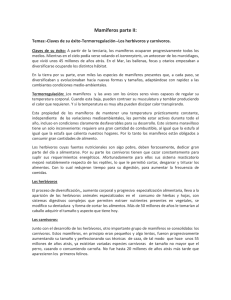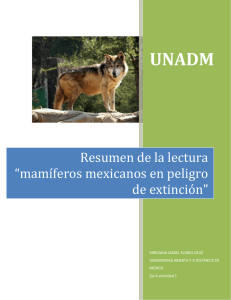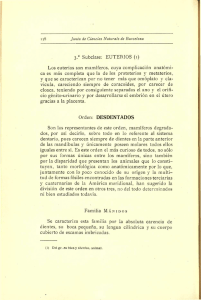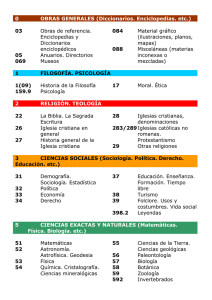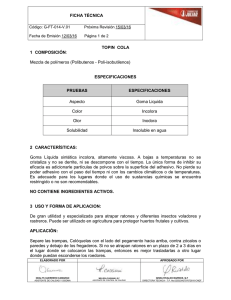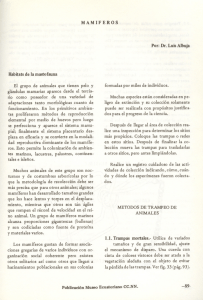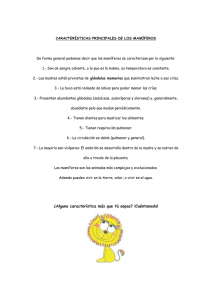Diversidad de mamíferos carnívoros terrestres en una selva
Anuncio
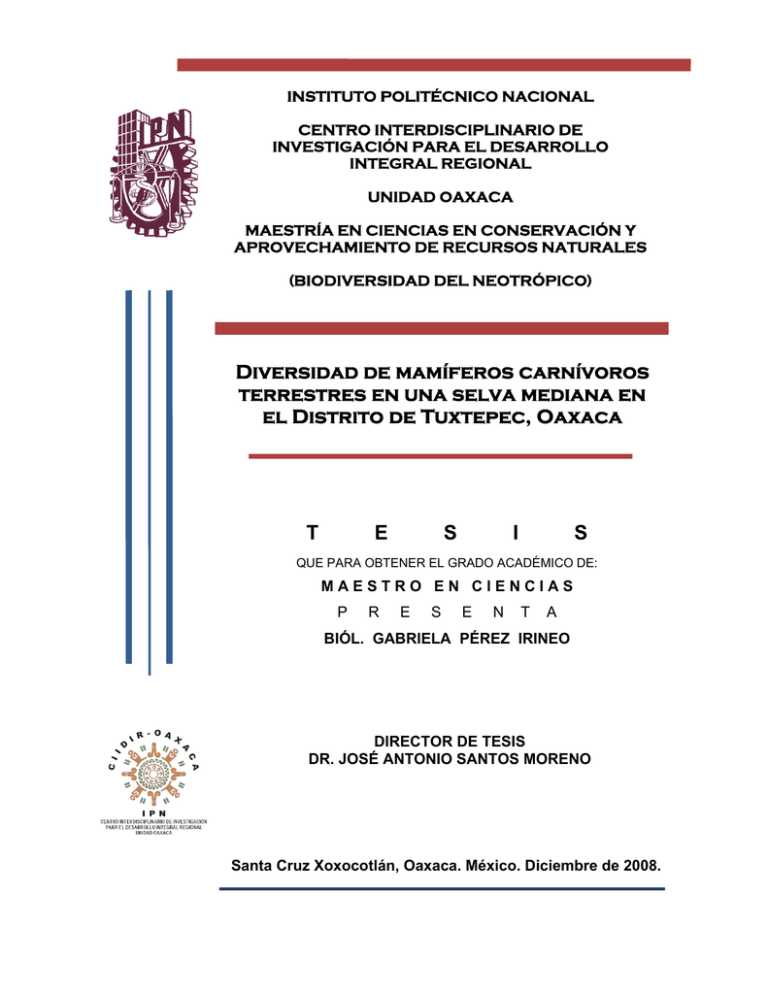
INSTITUTO POLITÉCNICO NACIONAL CENTRO INTERDISCIPLINARIO DE INVESTIGACIÓN PARA EL DESARROLLO INTEGRAL REGIONAL UNIDAD OAXACA MAESTRÍA EN CIENCIAS EN CONSERVACIÓN Y APROVECHAMIENTO DE RECURSOS NATURALES (BIODIVERSIDAD DEL NEOTRÓPICO) Diversidad de mamíferos carnívoros terrestres en una selva mediana en el Distrito de Tuxtepec, Oaxaca T E S I S QUE PARA OBTENER EL GRADO ACADÉMICO DE: MAESTRO EN CIENCIAS P R E S E N T A BIÓL. GABRIELA PÉREZ IRINEO DIRECTOR DE TESIS DR. JOSÉ ANTONIO SANTOS MORENO Santa Cruz Xoxocotlán, Oaxaca. México. Diciembre de 2008. DIVERSIDAD DE MAMIFEROS CARNIVOROS, TUXTEPEC DIVERSIDAD DE MAMÍFEROS CARNÍVOROS TERRESTRES EN UNA SELVA MEDIANA EN EL DISTRITO DE TUXTEPEC, OAXACA. Resumen Muchas especies de mamíferos carnívoros presentan problemas de conservación, sin embargo, dada su elusividad, los estudios ecológicos son difíciles para estas especies. En el estado de Oaxaca los estudios sobre mamíferos carnívoros son todavía escasos, a pesar de su importancia biológica, como controladores de las poblaciones de sus presas o como dispersores de semillas. Por lo tanto, el objetivo de este estudio fue caracterizar la riqueza y abundancia de la comunidad de mamíferos carnívoros de la selva mediana, en el Cerro Tepezcuintle, distrito de Tuxtepec, Oaxaca; así como determinar cual es el método de mayor eficiencia para el estudio de este grupo. Se recorrieron tres transectos entre dos y tres kilómetros de longitud para la búsqueda de rastros, capturas de organismos y avistamientos, con tres días de muestro mensual, de septiembre de 2007 a agosto de 2008. Se colocaron 216 trampas Tomahawk-día, 226 cepos-día, 262 trampas para huellas-día, 237 trampas cámara-día y 257 kilómetros recorridos. Se registraron cuatro familias, cinco géneros y seis especies de mamíferos carnívoros en esta comunidad. Las trampas para huellas registraron tres especies: Leopardus pardalis con 0.67 registros/trampas, Nasua narica con 0.25 y L. wiedii con 0.08 registros/trampas. Las trampas cámara registraron cuatro especies: L. pardalis con 0.43, N. narica con 0.29, Eira barbara y Urocyon cinereoargenteus cada uno con 0.14 registros/trampas. En los avistamientos y rastros sobre transecto se encontraron tres especies: N. narica con 0.87, Canis latrans con 0.09 y L. wiedii con 0.04 registros/kilómetros. La diversidad expresada por el índice de ShannonWiener fue de H´=0.49 para la comunidad de mamíferos carnívoros en la zona. Las trampas-cámara registraron la mayor diversidad (H’=0.46) y riqueza de especies (S=4) en comparación con las trampas para huella (H’=0.36, S=3) y los avistamientos (H’=0.21, S=3). No se registraron datos con las trampas Tomahawk ni en los cepos. Dado que los diferentes dispositivos registran parte de la diversidad de la zona y proporcionan diferentes valores en los parámetros estimados, su uso complementario es recomendable para lograr una mejor estimación de la riqueza y abundancia de mamíferos carnívoros. El sitio de estudio se encuentra inmerso en un mosaico de potreros, milpas, acahuales y zonas con vegetación natural, además se presenta un constante aclareo de zonas boscosas, lo que podría explicar la baja diversidad de este grupo de mamíferos. Palabras clave: riqueza, abundancia relativa, diversidad, mamíferos carnívoros, fototrampas, huellas, Cerro Tepezcuintle Gabriela Pérez Irineo 1 DIVERSIDAD DE MAMIFEROS CARNIVOROS, TUXTEPEC Abstract Many species of carnivorous mammal have problems of conservation, however, due to its difficult to see, ecological studies are difficult to make for these species. In the state of Oaxaca studies of mammalian carnivores are still scarce, despite their biological importance, such as controlling populations of prey or as seed dispersers. Therefore, the objective of this study was to characterize the richness and abundance of the community of mammalian carnivores of the subcaducifolious tropical forest, in Cerro Tepezcuintle, district of Tuxtepec, Oaxaca, as well as to determine which method is more efficient for the study of this group. It was walked three transects of two and three kilometers of length to search for evidences of organisms, trapping and sightings, with three days of sampling monthly from September 2007 to August 2008. Tomahawk traps were placed 216-day, 226 days-traps, 262 traps tracks-day, 237-day camera-traps, and 257 kilometers walked. Four families were recorded, five genera, and six species of carnivorous mammals in this community. The trap for tracks recorded three species: Leopardus pardalis with 0.67 records/trap, Nasua narica with 0.25, and L. wiedii with 0.08 records/trap. The camera-traps recorded four species: L. pardalis with 0.43, N. narica with 0.29, and Eira barbara, and Urocyon cinereoargenteus, each with 0.14 records/trap. In the sightings and evidences over transects were found three species: N. narica with 0.87, Canis latrans with 0.09, and L. wiedii with 0.04 records/kilometers. The diversity expressed by the Shannon-Wiener index was H'= 0.49 for the community of carnivorous mammals in the area. The trap-camera recorded the highest diversity (H'=0.46) and species richness (S=4) compared with the track traps (H'=0.36, S=3), and sightings (H'=0.21, S=3). There were no data with Tomahawk traps or leg-holds. Since different trap types recorded only part of the diversity of the area, and provide different values on the estimated parameters, their complementary use is recommended for achieving a better estimate of the real richness and abundance of carnivorous mammals. The study site is immersed in a mosaic of pastures, traditional culture systems, secondary vegetation, and areas with primary vegetation, also provides a constant cutting down of forest areas, which could explain the low diversity of this group of mammals. Gabriela Pérez Irineo 2
